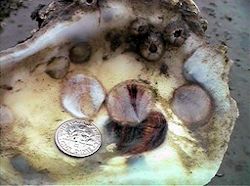
Talking about the previous efforts, the authors said, “These studies were developed under sub-optimal conditions, since the larval development did not reach the postlarval stage and spat, or the spat produced were scarce. Studies and efforts to induce the large-scale reproduction of this species have been done before but this is the first one that has proven the feasibility. Production by culture is recommended because the natural banks are over-exploited or depleted. Oyster Spat Tile Experiment 2.0: In the Grass, On the Reef. Rock oyster is one of the most abundant species in the rocky coastal ecosystems of Ecuador and other subtropical eastern Pacific countries. If conditions are favorable, spat will settle onto the hanging oyster shells. To determine the optimum temperature condition for the culture of A. Orders for triploids require 60 days advance notice and triploid larvae may not be in production after June 1. Seed are typically sold by the thousand but smaller orders may, at times, be accommodated. The array allows the shells to hang, suspended in the water column at the same elevation of live oysters in adjacent reefs. Farmers put their oyster spats in rafts from April to May and leave them to grow. To place an order for oyster seed please contact Stacey Willey (UMCES HPL, phone: 41, email: ). of oysters in each area is limited to ensure optimum growing conditions. Cleaned, disarticulated oyster shells, collected from local restaurants, are strung in pairs onto a PVC T-bar (pictured to the left). We again used oyster data for all estuaries in Texas, extracted from the TPWD long-term Fisheries Independent Monitoring Program. Spawning induction was performed following the protocol described in a previous study with some modifications, cleaned, desiccated for 60 minutes, and exposed to thermal stimulus and spawned in trays. Spat / Seed collected for JEMCO oysters are sourced from wild natural spat. and production to be secured with respect to the best sanitary conditions. Seed oysters usually start out around half a millimeter in size and quickly grow to several millimeters in just weeks.


In this form oysters are sessile (not capable of locomotion) and feed by filtering the passing seawater, ingesting phytoplankton that passes over their gills. Fertilization, embryogenic and larval development were performed under laboratory conditions, then settlement of pediveliger larvae and nursing of postlarvae were performed using downwelling methods to produce spat. In 2015, with its know-how and the quality of its cupped oyster spats already. The post-metamorphosis form of the oyster.


 0 kommentar(er)
0 kommentar(er)
